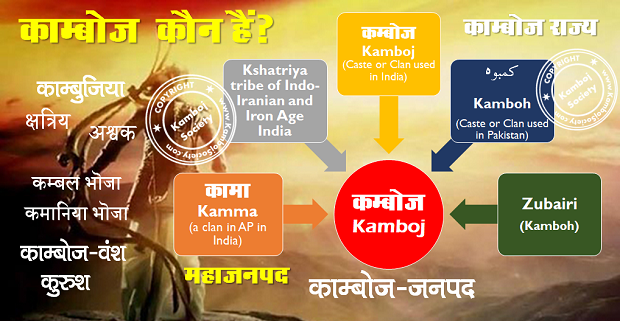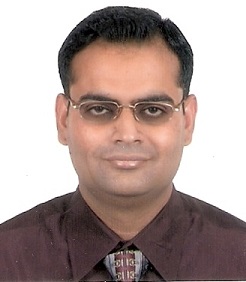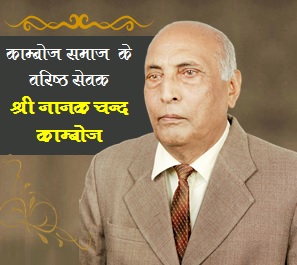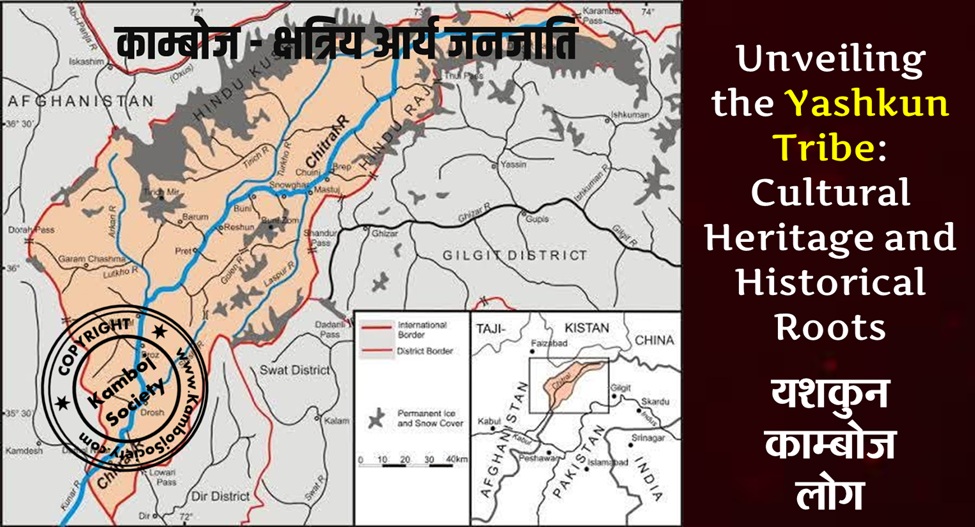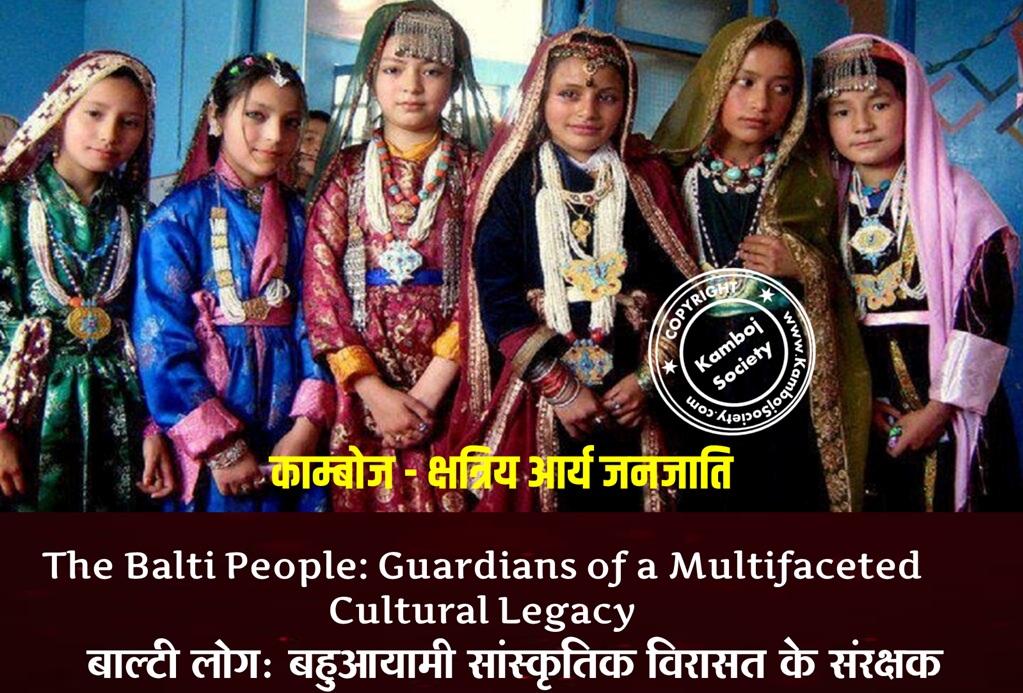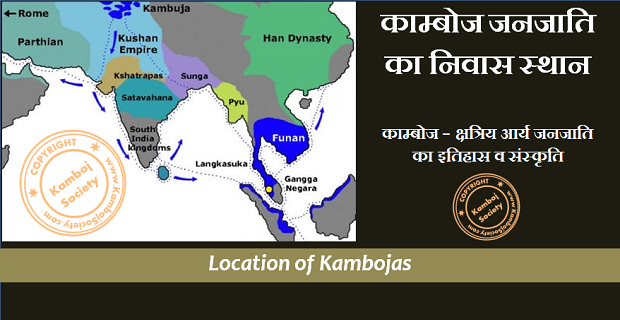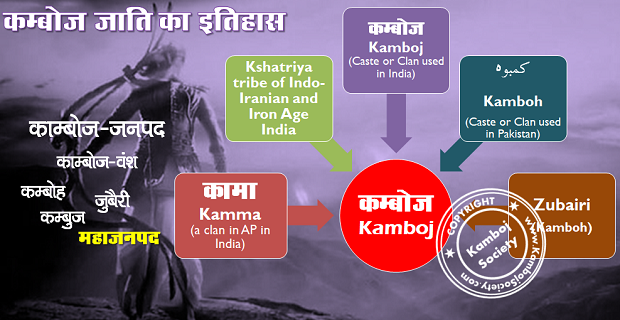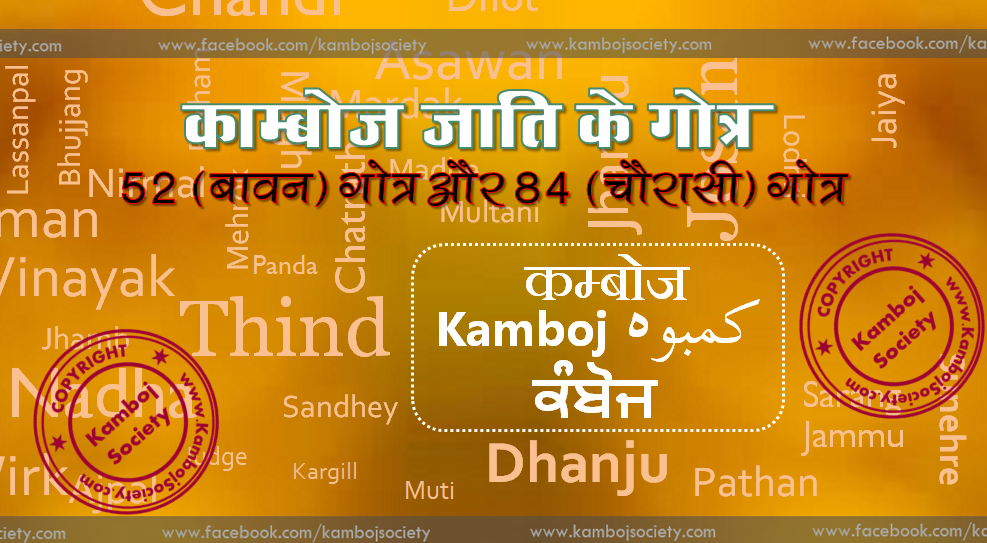Kamboj people are an ethnic community of the Punjab region of India and Pakistan. The Kamboj people are a traditionally agricultural community in Northern India and Pakistan. Primarily of Hindu, Muslim and Sikh faiths, they now live mostly in the Indian States of Punjab, Haryana, Delhi, Rajasthan, Uttarakhand and Uttar Pradesh and the Pakistani provinces of Punjab and Sindh.
Kamboj word in different languages
- In Hindi, Kamboj is written as कम्बोज or काम्बोज.
- In Punjabi, Kamboj is written as ਕੰਬੋਜ. Some places Kamboj people in Punjab are also pronounced as Kamboh (ਕੰਬੋ).
- In Urdu, Kamboj is written as کمبوہ. Urdu is spoken in Pakistan and mostly Kamboj people in Pakistan use Kamboh.
- In some literatures and scriptures, Kambhoj (कम्भोज) or Kambohoja (काम्भोज ) has been used to represent the ancient Kambojas tribe. These two words are primarily used in South-Indian versions of various literatures and scriptures which were written in Sankrit and Paali languauges.
Kamboj is frequently used as caste name or surname or last name in lieu of the sub-caste उपनाम or the gotra name गोत्र by many Kamboj people currently living in India. Their Muslim counter-parts living in Pakistan mostly use last name Kamboh instead of the gotra name. A good many Muslim Kamboh is also found in the Doab region of Uttar Pradesh, India, especially in the town of Marehra, and call themselves Zuberis.
The Kamboj are also found in Punjab, Haryana, Delhi, Uttar Pradesh, Uttaranchal and Ganganagar in Rajasthan. A minuscule agrarian community called Kambhoj is living in Maharashtra which probably has descended from those Kambojas who had settled in South-West India around Christian era.
The Kamboh are found in Punjab of Pakistan.
Kamboj are modern representatives of ancient Kambojas
The Kamboj people are the modern representatives of ancient Kambojas, a well known Kshatriya tribe of Indo-Aryans, stated to have had both Indian as well as Iranian affinities and mentioned in ancient Sanskrit texts and epigraphy. The Kambojas were an Indo-European Kshatriya tribe of Iron Age India, frequently mentioned in (post-Vedic) Sanskrit and Pali literature, making their first appearance in the Mahabharata and contemporary Vedanga literature (roughly from the 5th century BCE). Their Kamboja Kingdoms were likely located in regions on both sides of the Hindukush (see Kamboja Location). They apparently qualify as an Indo-Iranian people, better as Iranians, cognate to the Indo-Scythians. "It seems from some inscriptions that the Kambojas were a royal clan of the Sakas better known under the Greek name of Scyths". In the wake of Indo-Scythian invasion of India during the pre-Kushana period, Kambojas appear to have migrated to Bengal, Sri Lanka and Cambodia in the period spanning the 2nd century BCE and the 5th century CE. Their descendants held various principalities in Medieval India, the one in north-west Bengal being seized, around middle of tenth century CE, from the Palas in Bengal.
Kamboj Diaspora
The Kamboj or Kamboh living in upper India ( Greater Panjab) are identified as the modern representatives of the ancient Kambojas. They are found as Hindus, Sikhs, Muslims, Buddhists and the Jains.The Tajiks, Siyaposh tribe ( Kam/Kamoz, Katir/Kamtoz) of Nuristan, Yashkuns and the Yusufzais of Eastern Afghanistan and NWFP of Pakistan are said by various scholars to have descended from the ancient Kambojas.
Embraced Islam
During the early years of Islam in India, one of the groups of this clan embraced Islam at the instance of Shaikh Bahauddin Zakariya Suhrawardi (of Multan) and his son Shaikh Sadruddin. Some Kamboj, such as Shahbaz Khan Kamboh, occupied key military and civil positions during the Turkic and the Moghul reign in northern India. The historian M. Athar Ali said that "The Sayyids and the Kambohs among the Indian Muslims were especially favoured for high military and civil positions during Moghul rule".
Etymology
Kamboj Name derives from ancient Kamboja, an Indo -Iranian Aryan clan of Indo-European family, originally localized in Pamirs and Badakshan in Central Asia.
The meaning of Kamboj Word
The Sanskrit name Kamboja कम्बोज is also sometimes found written as Kambuja 'कम्बुज' as in Vedic texts like Paraskara Grhya Sutra 'पारस्करगृह्मसूत्रम् '(2.1.23). Kambojas is the plural form of Kamboja. The Kamboj word is derived from the Sanskrit word 'कम्बुज' (KAMBUJ). The meaning of Kambuj is 'क्षत्रिय की संतान' (Descendents of Kshatriya Tribe). In Hindi, Kamboj can be written in two ways: कम्बोज and काम्बोज and meaning of both the words are different. The meaning of कम्बोज (Kamboj) is children of Kamboj Kshatriya Tribe (कम्बोज क्षत्रिय की संतान) and काम्बोज (Kamboj) word refers to the country having to name Kamboj i.e. KAMBOJ COUNTRY (कम्बोज जनपद). Therefore the meaning of Kamboj word can be used as given below:- Name of Kamboj Kshatriya Tribe
- Name of Kamboj Country
- Name of Kamboj Kshatriya King
- Descendents or children of Kamboj Kshatriya Tribe
- Born or Native of Kamboj Country
कम्बोजा: कम्बलभोजा: कमनीयभोजा वा।
(निरुक्त 212 ॥)
अर्थात कम्बोज वे है जो कम्बल आदी ऊनी कपड़ों का प्रयोग करते हैं अथवा कमनीय वस्तुऔं का उपभोग करते हैं।
Kambojas are those people fond of wearing woolen blankets (Kambhalbhojas) and Epicureans, the people with fine tastes or enjoyers of excellent foods (Kamnyabhojas).
Ancient Kamboja country was mostly a hilly and cold land comprising Hindukush mountain range, Badakshan and parts of Tajikistan and Uzbekistan land north of Oxus river where fine varieties of grapes, pistachio, walnuts, almonds, saffron (Kesar), etc. were abundantly grown and are still grown and which formed an important constituent of Kamboja's people diet.
This example attests that the original word was Kambhoj used for Kambojas. Also, the word Kambhoj is used in renowned Kautilya Arthashashtra (कौटलीय अर्थशास्त्र) available from South India.
Varna status
As per the Hindu varna system Kamboj belongs to Kshatriyas (क्षत्रिय) in the caste system. Chudakarma Samskaara (चूड़ाकर्म (मुंडन) संस्कार) of Paraskara Grhya-Sutram (पारस्कराचार्यप्रणीतम् पारस्करगृह्मसूत्रम्:),Vamsa Brahmana (वंश ब्राह्मणम्) of the Sama Veda (सामवेद), the epic Ramayana (रामायण) as well as Mahabharata (महाभारत) and some other ancient references attest that a section of the Kambojas also practiced Brahmanism.
See: Brahmanism of Ancient Kambojas.
For Kambojas being a Kshatriya tribe
Overlap with Kshatriya and Brahmin clan names
The modern Kamboj are said to be divided into two divisions of 52 and 84 clans names (the actual number is however some what higher than these figures). Dr. Jiya Lal Kamboj observes that more than 15 of the Kamboj clan names overlap with that of the Brahmins and over 80 overlap with other Kshatriya and Rajput clans of northern India. But according to S. Kirpal Singh Dardi, the respective figures are over 25 overlapping with Brahmins and over 100 overlapping with other Kshatriyas and Rajputs. [4]In his well known book Glossary of Tribes and Castes of Punjab and North-westFrontier Province [5],British ethnographer and ethnologist, H. A. Rose, had also observed in early20th century that there is seen an overlap of the Kamboj clan names with that of the Brahmins and other Kshatriyas. Rose also admitted that the reason of this overlap was not clear to him [6].But, today with all the information provided in the articles in Wikipedia about the Kambojas, it would seem clear as to why there is such an overlap.
List of Kamboj Gotras (clans)
For more expanded list of Kamboj clans, click here
52 Gotras: Abdal, Ajpal Or Ajapal, Angiarey, Asoi, Bahujad, Bajye orBajne, Bage, Ban Or Bhaun or Bhawan, Barar, Batti Or Bhatti, Basra, Chak,Chandi, Chandna Or Chandne or Chand, Chatrath, Daberah, Dhanju, Dhot or Dhudi,Dote, Dulai, Handa Or Handey, Jaiya or Jie or Joiye, Jammu, Jaspal Or Jakhpal,Jatmal, Josan Or Jossan, Jaura Or Jaure, Judge, Kadi or Karhi, Khere, Kosle OrKausle, Karanpal, Kaura Or Kaure, Kayar, Khinda Or Khinde, Kirgil, Lori OrLaure, Mardak, Mehrok Or Mirok, Momi, Mutti or Moti, Nadha Or Nandha Or Nandhey,Nagpal, Nagri Or Nagra, Nandan, Nibber Or Nibher, Padhu Or Pandhu, Patanroy OrPatanrai, Pran, Ratanpal, Sama, Sandha Or Sandhey, Sandher, Sandheyer orSandheer, Sawan, Soi or Sohi, Shahi, Suner, Tandne, Tarikha or Trikhe, Thind, Tume, TurneOr Turna, Vinayak, Pathan, Unmal
84 Gotras: Aglawe, Ambri Or Ambrey, Angotre, Bagwan Or Bagyan OrBagban, Bahia, Bangwaye, Bangar Or Bangare, Banjahal Or Bhunjal, Banur, Barham,Barhgotey, Bassi Or Basi, Bastorh, Beeharh Or Beharh, Bhujang, Brahman OrBehman, Chamri Or Chimre, Chaupal Or Chaufal, Cherta Or Churta Or Churawat,Chhanan Or Chhiyanwe, Chhichhoti Or Chhichhote Or Chhachhate Or Chhachha,Chichare Or Chachare, Chimne Or Chimni or Chimna, Chine Or Chini or China,Churiye Or Chirwey Or Chidey Or Charway, Dange, Datane Or Dotane or Datana OrDutane, Dehar Or Dehal, Dehgal Or Duggal, Dhare, Dheel Or Dhillan, Dhehte, Dode,Doliyan, Fukni, Gadre or Gadra, Gagre or Gagra, Gande Or Gandi, Gandheyor orGandhare Or Gandhi, Gaure Or Gore Or Rai Gore Or Gori, Geelawe, Ghasitey, GoganOr Gugan, Gosiley, Gal or Gayile or Goyale, Ghangra, Harse, Jade or Jarhe,Jagman, Jande, Jangle Or Jangli, Jhamb Or Jham, Jhand Or Jhandu, Kalra Or Kalre,Kalar, Kalsia Or Kalsi Or Kalas, Camari or Kamari or Khamare, Khokhar, Kokar OrKakar Or Kakra, Kukri Or Kukar, Lahere Or Lehri, Lakhi, Lahndey, Latte, LahangeOr Lahinga Or Lahinde, Lall, Machhliye Or Machhle, Magu or Mage, Makore OrMakkar, Mall, Momsarang, Sarang, Mandey or Mande, Melle Or Meliye Or Malle,Multani, Nagambr Or Nigambar, Nehriye Or Nehre Or Ner Or Naru,Or Nehru OrNauhriye, Nepal Or Nipal or Naipal, Nuri, Pandey Or Pandhey, Padhasi, Sainik,Sandle, Sathand, Senpati Or Senapati, Sapre Or Sapra Or Sawre, Sarnote OrSarkude, Satte, Sauki or Soki, Soni, Suhagi Or Suhage, Sunehre,Silahre/Sulahre/Sulehre, Sulhiro, Tande, Tagal Or Tugal, Taparhiye, Thathai OrThathaiya or Thathe, Thingrey Or Thengrey, Topchi
Kamboj Culture
Kamboj men and women remain to be one of the most important and finest class of agriculturists of India especially in Punjab and Haryana, which is why many of them have a strong physique, as well as aryan features which have been given to them via their ancient Kamboja ancestors, ancient Kamboja, an Indo -Iranian Aryan clan of Indo-European family. The Kambojs in both Punjab and in other states in India are found in a variety of other developed nations such as America and the United Kingdom, where they have developed successful businesses and employment.
In fact, because of the fact that the Kambojs own most of the land in Punjab and Haryana and therefore work on it to produce wheat, rice and various other food grains and vegetables, it has boosted Punjabs economy and therefore decreased amounts of poverty in the region.
Pronunciation
kum'bojNoun
Kamboj (plural: Kambojs)
- Name of a community, of Indo-Iranian extractions living in north India and Pakistan.
- A member of this community.
Alternative spellings
- Kambhoj
- Kamboz
- Kambuj
- Camboj
- Kamboh
- Kambu & Kambo (found in medieval age muslim records)
Adjective
Kamboj (no comparative or superlative)
- Relating to the Kamboj people.
References
- See: Vedic index of names & subjects by Dr. Arthur Anthony Macdonnel, Dr Arthur. B Keath, I.84, p 138; Afghanistan, p 58, W. K. Fraser, M. C. Gillet; Afghanistan, its People, its Society, its Culture, Donal N. Wilber, 1962, p 80, 311 etc.
- Paraskara Gryya-sutram verse 2.1.2; Commentary: Pt Harihar.
- Vamsa Brahmana verse 1.18-19.
- The Kambojas Through the Ages, 2005, p 27, 431.
- Based on 1880 census of India
- Glossary of Tribes and Castes of Punjab and North-West Frontier Province, 1915, Vol II, p 444-445 fns, H. A. Rose


